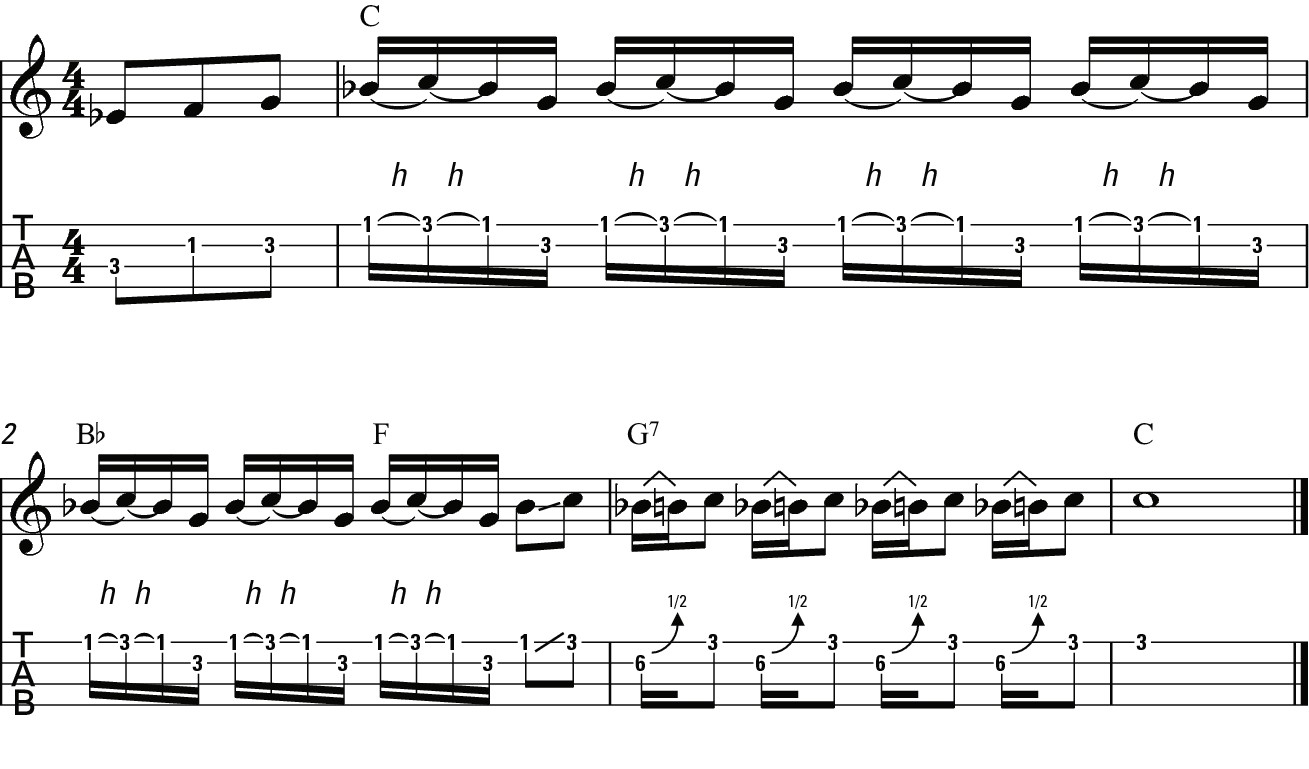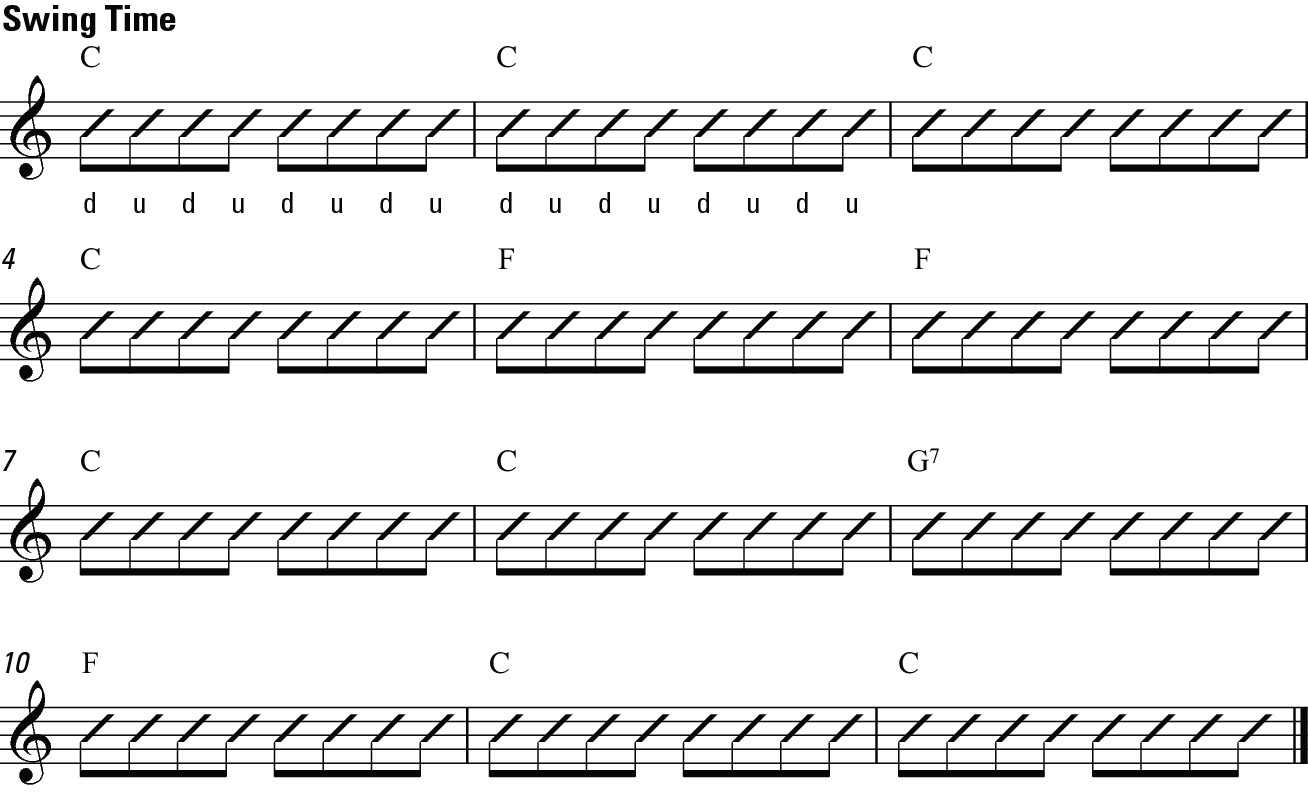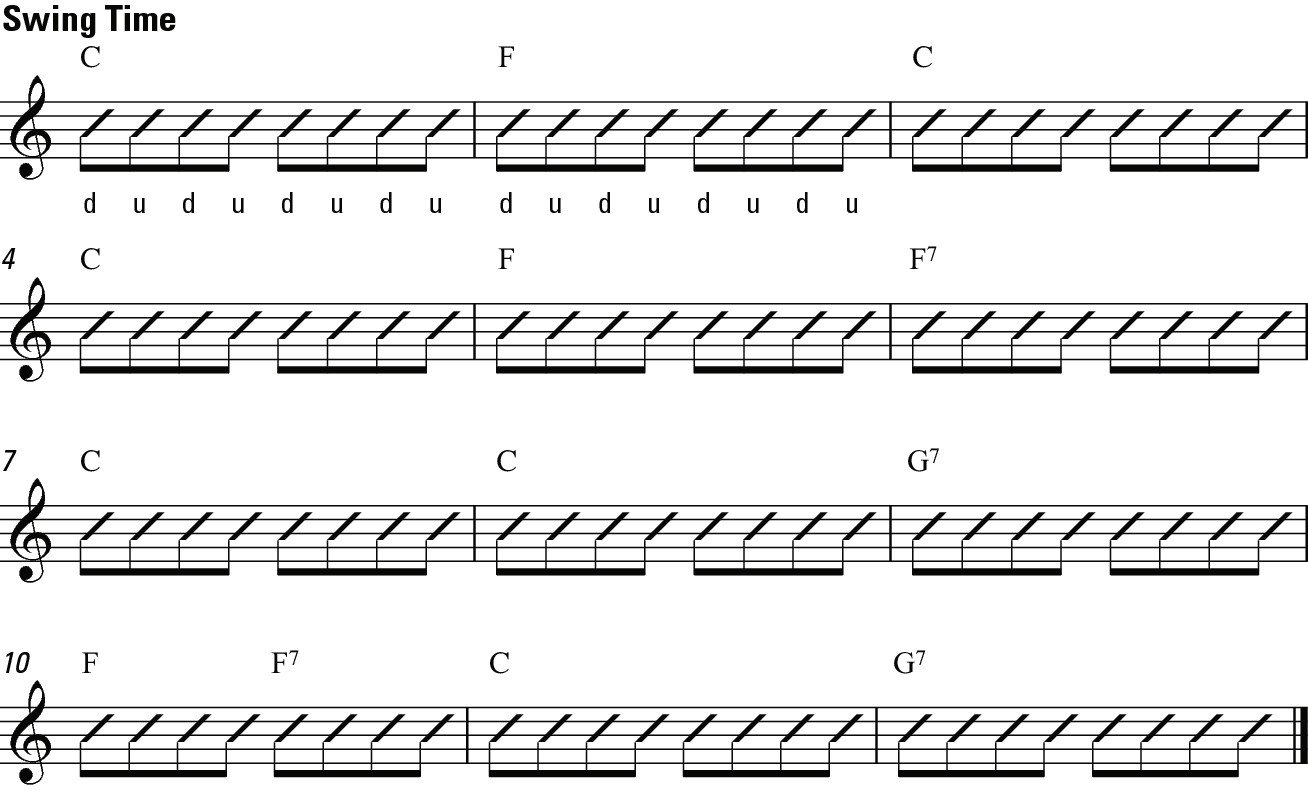Ukulele For Dummies (50 page)
Read Ukulele For Dummies Online
Authors: Alistair Wood

Articulating questions and answers
Playing one line that sounds like a question followed by a line that sounds like an answer is a particularly effective way to phrase a solo. When you ask a question your voice naturally goes up at the end. If you play a phrase that goes up at the end, people hear that as a question; the effect is to create momentum in the solo because setting a question makes you expect an answer. And you can provide that answer by playing a phrase that moves downwards and has a firm and confident resolution to it.
 Figure 11-19 (Track 62) shows a question and answer phrase, which you play as follows:
Figure 11-19 (Track 62) shows a question and answer phrase, which you play as follows:
1. The question moves upwards and ends with a slide up.
2. The answer moves downwards and ends with a slide down.
Figure 11-19:
Question and answer phrasing.

You can hear this technique used very effectively at the start of âHideaway' by Freddie King (and covered by Eric Clapton on the classic John Mayall
Blues Breakers
album).
Moving up the fretboard for tension and release
A good solo gradually builds up to a crescendo at the end. You achieve this effect by starting low on the fretboard and playing relatively slowly. As the solo goes along, move up the fretboard and increase the tempo.

Transferring guitar chords and tabs to ukulele
Even though an increasing amount of ukulele material is available, you can still find guitar chords and tabs more easily. Therefore, being able to transfer this material to the ukulele is useful.
Transferring guitar chords is dead easy: just play the chords as written. If the guitar chord chart indicates a C chord, play a C chord on the ukulele.
The only issue you face is
slash chords
(which are written with a slash in the middle). So you may see C/G, D/F or C/B. The part before the slash is the chord (C, D and C, respectively) and the second part is the bass note. But the ukulele has no bass notes. You have two ways to deal with this problem:
or C/B. The part before the slash is the chord (C, D and C, respectively) and the second part is the bass note. But the ukulele has no bass notes. You have two ways to deal with this problem:
 If the chord already contains the note, the best thing is to ignore it. For example, G is already in the C chord and so you can just play C for C/G.
If the chord already contains the note, the best thing is to ignore it. For example, G is already in the C chord and so you can just play C for C/G.
 If the note isn't in the chord (for example, B isn't in the C chord), add it in if you're playing alone or let a bass instrument handle it if you're playing in a band.
If the note isn't in the chord (for example, B isn't in the C chord), add it in if you're playing alone or let a bass instrument handle it if you're playing in a band.
Unfortunately, guitar tab is much harder to transfer to the ukulele. It can take a lot of fretboard knowledge to do this fully, but you can apply a few techniques that often work.
The top three strings are tuned like the top three strings of a guitar starting at the fifth fret. So any guitar tab played on the top three strings above the fifth fret can be transferred to your uke by taking away five from the fret number. So, for example, if the guitar tab shows the top string of the guitar being played at the ninth fret, you play the top string of the uke (A) at the fourth fret.
As the end of the solo approaches, you can build the tension by taking a short (three- or four-note) phrase and repeating it a number of times. The longer the repetition continues, the more tension you create and the bigger the release at the end of the solo.
 Don't overdo it. Think of this technique as if it's an elastic band. The more you pull it back, the bigger the twang when you release it. But pull it back too far and it breaks. Similarly, if you repeat a phrase too many times the listener may well want to break your legs!
Don't overdo it. Think of this technique as if it's an elastic band. The more you pull it back, the bigger the twang when you release it. But pull it back too far and it breaks. Similarly, if you repeat a phrase too many times the listener may well want to break your legs!
 Figure 11-20 (Track 63) takes a four-note move and repeats it (building tension) before ending with a few bends, to release the tension and finish the solo.
Figure 11-20 (Track 63) takes a four-note move and repeats it (building tension) before ending with a few bends, to release the tension and finish the solo.
Figure 11-20:
Tension-building phrase for the climax of a solo.

Chapter 12
Playing the Blues to Lift Your Spirits
In This Chapter
 Shaping the 12-bar blues to your needs
Shaping the 12-bar blues to your needs
 Playing the classic blues turnaround and its variations
Playing the classic blues turnaround and its variations
 Using the blues scale in solos
Using the blues scale in solos
A
lthough blues music isn't a genre you immediately associate with the ukulele (nor for that matter is rock music, which I cover in Chapter 11), the style has a long and noble tradition on the instrument. The uke was used for early jazzâblues hybrid styles at the beginning of the 20th century and the first true blues ukulele player was one Lewis âRabbit' Muse. More recently, long-time blues musicians such as Taj Mahal and Peter Madcat Ruth have taken up the ukulele and some blues acts (for example, Manitoba Hal) use it as their main blues instrument.
With all due respect to the noble history of the blues, by far the most important aspect of blues playing is to master the intense facial expressions! From B.B. King's hangdog look and Gary Moore's bikini-wax face to the ubiquitous head-back ecstatic wail, getting the expression right takes many hours of concentrated practice in front of a mirror!
When you have the facial contortions down, this chapter can walk you through the secondary aspect: the actual playing. I discuss some of the most recognisable characteristics of the blues and how to create that blues sound on your uke, covering the classic 12-bar blues and its many variations, the blues shuffle and blues soloing.
Playing Blues Chord Progressions
The basis of the blues is the 12-bar chord progression (which I introduce in Chapter 5). The chord progression is highly adaptable, and this section takes you through some of the possible variations: rearranging the chords, adding chords and varying the progression's length.
Performing a simple 12-bar blues
 The 12-bar blues is based on a IâIVâV progression (check out Chapter 6 for details of the chord families). Therefore, in the key of C the chords are C, F and G7, which you play in the pattern shown in Figure 12-1 (Track 64).
The 12-bar blues is based on a IâIVâV progression (check out Chapter 6 for details of the chord families). Therefore, in the key of C the chords are C, F and G7, which you play in the pattern shown in Figure 12-1 (Track 64).
Figure 12-1:
Simple 12-bar blues in C.

 The strumming for all the examples is dead simple (just down, up, down, up) but ensure that you make the music swing (Chapter 5 provides more info on swing).
The strumming for all the examples is dead simple (just down, up, down, up) but ensure that you make the music swing (Chapter 5 provides more info on swing).
Varying the 12-bar blues
 You can vary the 12-bar blues by changing the order of the chords and making use of the IV7 chord (in this case, F7) to get a variation like the one in Figure 12-2 (Track 65).
You can vary the 12-bar blues by changing the order of the chords and making use of the IV7 chord (in this case, F7) to get a variation like the one in Figure 12-2 (Track 65).
Figure 12-2:
Variation on the order of the 12-bar blues.

 Adding chords to it is another way to vary the 12-bar blues. A fret above the V chord is the commonest chord to add. So in the key of C you include an A
Adding chords to it is another way to vary the 12-bar blues. A fret above the V chord is the commonest chord to add. So in the key of C you include an A 7 chord (shown in Figure 12-3) to create the chord progression in Figure 12-4 (Track 66).
7 chord (shown in Figure 12-3) to create the chord progression in Figure 12-4 (Track 66).
Figure 12-3:
A 7 chord diagram.
7 chord diagram.

